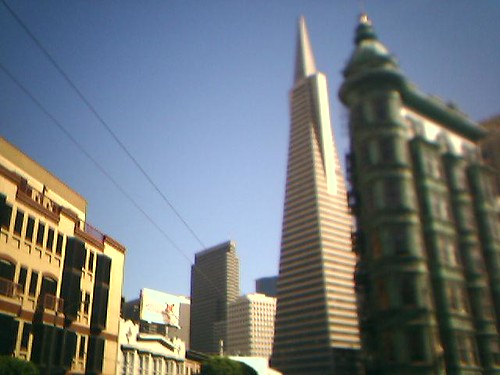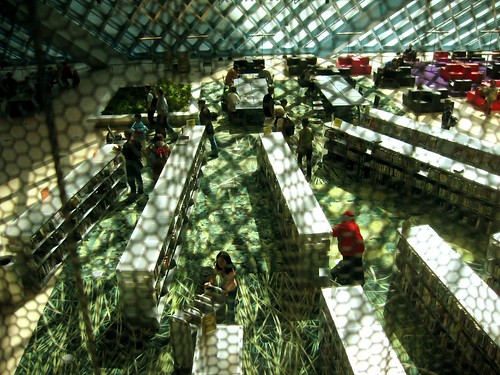For the last three days, I served on a jury in a civil trial in San Francisco Superior Court. It was a personal injury case stemming from an auto accident on the Bay Bridge in 2002. The plaintiff sought cash for physical and mental suffering, inconvenience, loss of enjoyment of life, and about six other things. I had some idea of how totally jacked California personal injury law is. After seeing the way that this case played out, I am shocked and depressed by it.The facts. There was no question that the defendant (a round-ish kid from outside Sacramento) rear-ended the plaintiff (an Asian lady from El Cerrito). The question was: Was there enough evidence of actual harm to award some kind of money? The plaintiff's car was unharmed by the collision. She drove home immediately afterward. An expert witness argued that the collision could not have been more than a slight bump. In my opinion, the plaintiff offered no evidence to support her argument. She claimed various types of harm: 18 months of back problems, inability to have intimate relations with her husband (ouch), general family dissolution. But her tearful testimony was the only evidence of her suffering. There was no testimony or deposition from her doctor, no medical records, no police report, no testimony from her husband or kids; moreover, she continued to work immediately after the accident and admitted that she missed no work — including business trips to China and Seattle — as a result.Our task. We had a total of four questions to answer; but if we ruled "no" on any of the first three, our work was done. Case closed. The first question: Was the defendant was negligent? If we agreed he was negligent, question two: Was the plaintiff harmed? If so, question three: Was the defendant a substantial factor in the harm? Finally, if he was: How much money should be awarded for the harm?1. Was the defendant negligent? Umm, yeah. The guy rear-ended her. Hard to say he wasn't. Still, you had to feel bad for him. He was working at a pizza place at the time of the accident, and you had to know that he was fearing some kind of huge verdict. Nevertheless, his testimony was unconvincing. A "reasonably careful" person would not rear-end a car in that situation, even if he was sneezing, as he claimed. About half the jury initially wanted to say that he was not negligent, but the rest of us had a hard time ruling that he wasn't. He wasn't paying attention. A reasonably careful person would have been paying attention. After 10 minutes of discussion, we came to a decision: 12 yes, 0 no.2. Was the plaintiff harmed? This is where it got testy. I personally believed that if we said "yes" to this, we were going to have to award damages. So I argued (at length) that she wasn't harmed, and at first 7 other jurors agreed. We only needed one more to turn to our side to win — in California, you only need 9 out of 12 jurors to agree on a point to come to a decision. Unfortunately, one of the characteristics of harm was "inconvenience." The minority argued — persuasively enough, as it turned out — that the fact that she had to stop on the Bay Bridge during crazy weekend traffic was enough to say that she was harmed. Eventually, they had the required 9, including three other young guys who I thought were going to be faithful allies (they were from the Mission, Upper Haight, and Potrero Hill). Interestingly, the other two who believed that she wasn't harmed were women: one was an older Asian lady (Sunset), and another was a young woman from the Marina. Final score: 9 yes, 3 no.3. Was the defendant a substantial cause of the harm? It was really hard to say "no" to this if you said "yes" to the above question because of inconvenience. I started to get really nervous that we were going down a path where we were going to award her some money because she got bumped on the Bay Bridge, and claimed to have incurred all sorts of hardship. Again: 9 yes, 3 no.Aside: It was pretty clear that the accident was traumatic to the plaintiff; she cried throughout the trial, and her rendition of the accident made it sound pretty scary. It happened over the weekend, so the traffic was crazy, and the defendant handled himself badly. BUT, she didn't file a suit until two years later, didn't keep receipts for medical treatment, didn't have any testimony from doctors or family members. Without any of this, it seemed insane, really, to say with any certainty that she was harmed. It's not like it's hard to produce this evidence. C'mon!4. How much is the plaintiff entitled to for her mental/physical suffering? At this point, the foreman used the whiteboard to write out each element of physical and mental suffering (loss of enjoyment of life, inconvenience, etc), laying out a framework where we would agree on a value for each thing. In California, juries are given no guidelines for determining the award; we're left to our own devices.The foreman said, "I'm just going to throw out a figure. $5000." Upper Haight guy said, "$3000." Another two women chimed in with $3000. Immediately, there were four people who wanted to award money for her unsupported claims. Luckily, Potrero Hill and Mission guys were even more passionate than me about this, and they immediately articulated an argument that I hadn't expected: that inconvenience on the Bay Bridge has a monetary value of ZERO dollars. The three Asian ladies immediately agreed, as did the Marina lady.The foreman kept proposing figures — "Okay, how about $2000?" — but Potrero Hill guy interjected: "Hey, we've got 8 people who believe that she shouldn't get anything. You're in the minority. You need to come to us." Eventually, we were arguing about whether or not to award $250. Finally, a little after 4pm, the foreman cracked: "Okay, fine. Zero dollars." And justice was served: 9 $0, 3 $250.But the depressing thing was how easy it was to assign monetary damages, how much the logic of the law seemed destined to lead to it. Upper Haight guy was brainwashed by it. Even though he could never articulate a pragmatic reason why she should get any money, he kept referring to the jury instructions and saying, "I'm just following these rules. She was inconvenienced, and now we have to assign a value to that." The foreman was sympathetic — he had family members who had been in a much worse position and got no money — which he acknowledged was not a valid legal reason, but it took him an hour before he abandoned this. As the verdict was read — negligent, harmed, substantial cause of harm — the defendant looked scared, and his attorney looked depressed. Then, the big fat $0 of damages, and everything changed. The plaintiff's attorney slumped, and the plaintiff began crying again. The defendant was relieved, and the judge actually looked relieved as well. Justice was served. Barely.
Author: Doug LeMoine
Photos / Underwater buildings
Sometimes, the crappy lens on my Motorola v220 produces interesting effects. Recently, it has started compressing the depth of field, and at the same time, arbitrarily fuzzing out objects. When directed at buildings in full late-afternoon light, it actually makes things look like they're in an aquarium.



 If you're like me, one of your favorite parts of seeing new cities is checking out the logo(s) of their public transit system. Nowadays you don't even need to travel to these cities to appreciate their variety; here's a site with an amazingly thorough catalog.
If you're like me, one of your favorite parts of seeing new cities is checking out the logo(s) of their public transit system. Nowadays you don't even need to travel to these cities to appreciate their variety; here's a site with an amazingly thorough catalog.
Fresh Air interview w/ Mike Mills
Mike Mills is a graphic designer, director of many excellent music videos (among them: "Kelly Watch the Stars," by Air, the one with the 70's‑looking slow-motion ping-pong players), and all-around aesthetic bad-ass. Terry Gross interviewed him on Fresh Air a couple of weeks ago, and you can check out the archived version on the NPR website. It includes a funny anecdote about his experience as an apprentice for a well-known Scottish artist — at the risk of giving away the ending, Mills didn't assist in the creation of the work as much as he created the work for the artist, who was too hungover to do it himself. Here's a really comprehensive collection of his video work, including "Kelly Watch the Stars."Incidentally, when I was growing up, a different Mike Mills was the bassist for my favorite rock band c. 1985–88 — REM. You can hear his thin, poignant harmonizing on Murmur, Reckoning, Fables of the Reconstruction, Life's Rich Pageant, Dead Letter Office, and Document. (Don't bother with anything after Document; it's all downhill from there). Let's hear it for all Mike Millses!
Burgers in SF
After a chill afternoon at China Beach, we checked out some burgers at Bill's Place, which made me think about all of the good burgers to be found in San Francisco:
- Bill's Place (pictured) grinds its own, and names its burger platters after local celebrities. Extra credit for the chandeliers and non-mayo cole slaw. On the downside, it's unjustifiably pricey. $10 for a burger? Maybe at Zuni, but it seems weird to pay this much at a diner.
- If you're interested in diner-style ambiance more than good-tasting burgers, you can check out Joe's Cable Car. I really wish that the burgers tasted good there, but the reality is that they don't.
- For fake retro ambiance, high tourist quotient and really mediocre burgers, Mel's is your place. There are at least three very unconvenient Mel's locations, if you're Mission/Lower-Haight based.
- Slow Club has (or used to have) a good yuppie burger — sprouts and fancy aioli, on some kind of Euro roll. Being from the Midwest, I dislike froofy interpretations of burgers, but in weaker moments I have been known to order this burger. And enjoy it.
- Speaking of froofy, Zuni serves a burger amidst its generally tasty Cali cuisine. In 1996-ish, I could not bring myself to admit that it was good; in 2005, I can.
- On cold nights, Zeitgeist can ring your chimes with a good char-burger. On warm, busy nights, expect extra char.
- BurgerMeister and Burger Joint are all about happy cows (Niman Ranch beef), sterile, fluorescent-lit dining rooms (creepy) and, in the end, similar burgers. Hipsters split hairs about which is better. I call it a tie. (But the Meiser has Mitchell's ice cream.)
- I'm a recent convert to the virtues of Big Mouth in the Mission. Quality control is in full effect on both fries and burgers, plus greasy-spoon atmosphere distinguishes it from the sterile environs of the BJs and BMs of the world.
- Everyone talks about Barney's Gourmet Hamburgers but I personally don't see what the fuss is about. It's not that I dislike white people, but it annoys me that the owners avoid all but the whitest of white neighborhoods — North Berkeley, North Oakland, Noe Valley. Dude, next stop: Mill Valley.
There are lots more. I'll update soon.
I took this picture in a small atrium overlooking the lobby of the Seattle Library, designed by Rem Koolhaas and opened a year ago. As Mara and I enjoyed the cool, green light, we overheard a conversation that went something like this:Middle-age woman to her husband: I can't believe they spent so much money on this thing.Husband: It's absurd. What's in a library? Books. You don't need all this other stuff.Middle-age woman to Mara: What a waste of money, right?Mara: [Flabbergasted]People raise the same argument when cities build new sports stadiums. Of course, stadiums bring in huge amounts of revenue and, the last time I checked, libraries were free. On the other hand, stadiums house teams owned by zillionaires who, the last time I checked, could probably afford to build the stadiums themselves.In any case, the taxpayers of Seattle have contributed to the construction of an amazing public space where EVERYONE can go, read, hang out FREE OF CHARGE and be inspired by the wisdom of the ages surrounding them. I can't imagine a better environment in which to do this. Citizens of Seattle, I salute you.
Law nerds around the country are providing interesting commentary of the Roberts confirmation. SCOTUSblog provides a blow-by-blow account of the posturing and intermittent questioning of the senators alongside interesting legal commentary, but it's a blog, so you have to scroll down to the bottom and read upwards if you want to read chronologically. Balkinization, a blog that includes many quite interesting essays by Yale Law professor Jack Balkin, has an interesting discussion about why Democrats should not confirm Roberts. Balkin recently published an interesting piece in Slate about originalists and the concept of a living constitution: "Alive and Kicking: Why no one truly believes in a dead Constitution."If you're willing to sift through the details — and each memeber of the Senate Judiciary Committee tends go into excessive detail before getting to his/her question — the NYT has raw transcripts: Day 1, Day 2.
After Hurricane Katrina, the recent Harper's magazine feature about the uncontrollable, unfathomed termite infestation of the French Quarter seems downright eerie. Equal parts information and meditation, Duncan Murrell's "The Swarm" is an effective, moving blend of first-hand reporting on blizzard-like termite swarms, spooky interviews with insect experts, and genuine Southern gothic moments:
Where the Formosans are foraging — in the studs of a wall, for instance — the carton sometimes takes the shape of the very thing they're eating. Pest-control operators in New Orleans told me many of stories of ripping out drywall to expose what looked from a distance like solid two-by-four framing pieces, only to find that they were looking at carton nests, the ghosts of a wall long since consumed.
It also provides a peek into the world of the termitologist, touching on the tragic tale of a manic-depressive South African entomologist who became so obsessed with termites that he began to view their behavior in perhaps overly sophisticated terms:
[Eugene] Marais believed that colonies of termites were distinct, compound organisms not unlike the human body, that every component from queen to worker served a function not just analogous but identical to the function of our own hearts and livers and brains and blood cells. Marais thought that the termite colony lacked only the power to move together as one organism, and that someday they would develop even that skill.
Next on my reading list: Marais's "classic work of obsessive observation," The Soul of the White Ant.
The British street artist Banksy just painted nine provocative murals on the wall that separates the West Bank from Israel. The sardonic quote in the title is Banksy's reflection on his work there. He goes into a little more detail on his site. The Guardian and BBC both covered it, and there is at least a little disagreement over the meaning and relevance of politically-motivated street art here and here.While we're on the subject of Banksy, here's my previous favorite project of his. As the BBC sub-head describes it, "Fake prehistoric rock art of a caveman with a shopping trolley has been hung on the walls of the British Museum."





